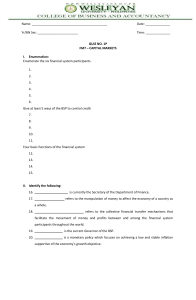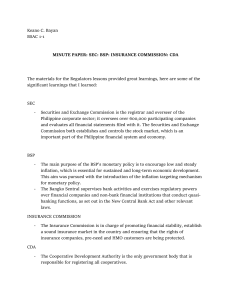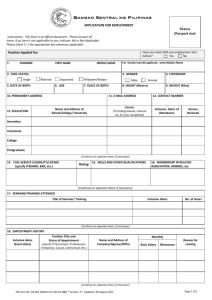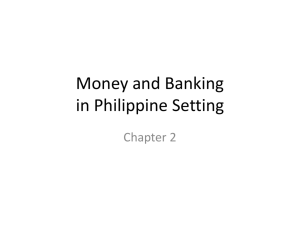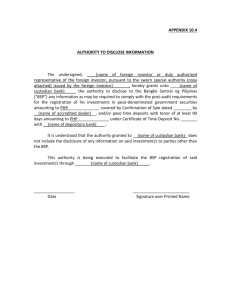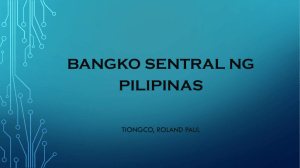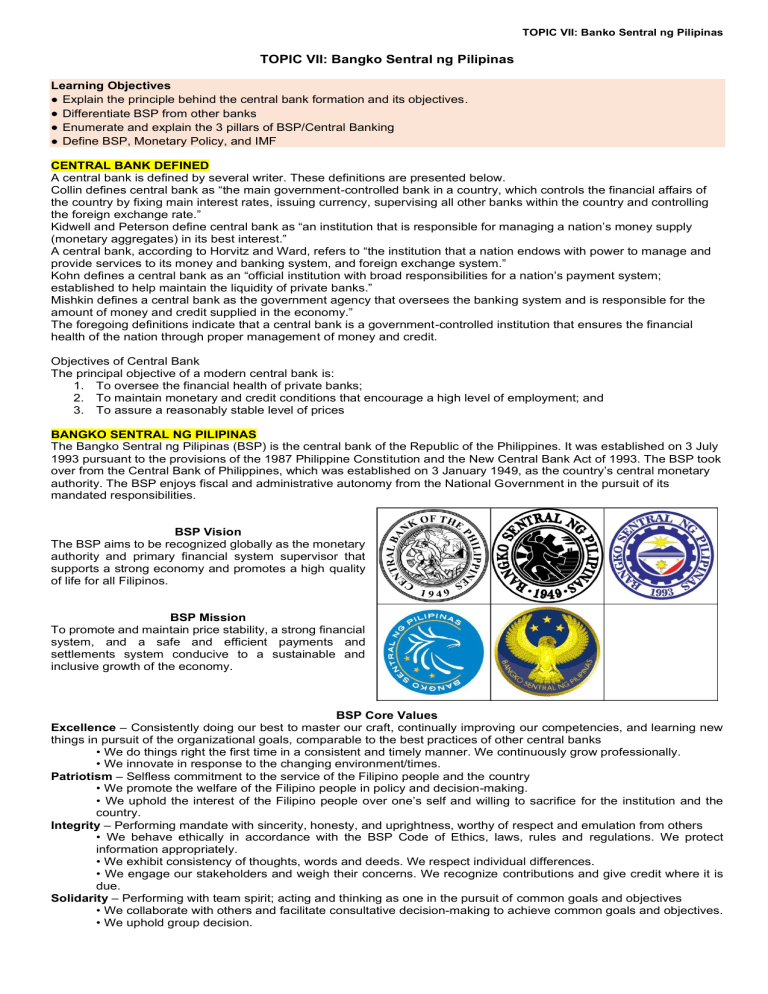
TOPIC VII: Banko Sentral ng Pilipinas TOPIC VII: Bangko Sentral ng Pilipinas Learning Objectives • Explain the principle behind the central bank formation and its objectives. • Differentiate BSP from other banks • Enumerate and explain the 3 pillars of BSP/Central Banking • Define BSP, Monetary Policy, and IMF CENTRAL BANK DEFINED A central bank is defined by several writer. These definitions are presented below. Collin defines central bank as “the main government-controlled bank in a country, which controls the financial affairs of the country by fixing main interest rates, issuing currency, supervising all other banks within the country and controlling the foreign exchange rate.” Kidwell and Peterson define central bank as “an institution that is responsible for managing a nation’s money supply (monetary aggregates) in its best interest.” A central bank, according to Horvitz and Ward, refers to “the institution that a nation endows with power to manage and provide services to its money and banking system, and foreign exchange system.” Kohn defines a central bank as an “official institution with broad responsibilities for a nation’s payment system; established to help maintain the liquidity of private banks.” Mishkin defines a central bank as the government agency that oversees the banking system and is responsible for the amount of money and credit supplied in the economy.” The foregoing definitions indicate that a central bank is a government-controlled institution that ensures the financial health of the nation through proper management of money and credit. Objectives of Central Bank The principal objective of a modern central bank is: 1. To oversee the financial health of private banks; 2. To maintain monetary and credit conditions that encourage a high level of employment; and 3. To assure a reasonably stable level of prices BANGKO SENTRAL NG PILIPINAS The Bangko Sentral ng Pilipinas (BSP) is the central bank of the Republic of the Philippines. It was established on 3 July 1993 pursuant to the provisions of the 1987 Philippine Constitution and the New Central Bank Act of 1993. The BSP took over from the Central Bank of Philippines, which was established on 3 January 1949, as the country’s central monetary authority. The BSP enjoys fiscal and administrative autonomy from the National Government in the pursuit of its mandated responsibilities. BSP Vision The BSP aims to be recognized globally as the monetary authority and primary financial system supervisor that supports a strong economy and promotes a high quality of life for all Filipinos. BSP Mission To promote and maintain price stability, a strong financial system, and a safe and efficient payments and settlements system conducive to a sustainable and inclusive growth of the economy. BSP Core Values Excellence – Consistently doing our best to master our craft, continually improving our competencies, and learning new things in pursuit of the organizational goals, comparable to the best practices of other central banks • We do things right the first time in a consistent and timely manner. We continuously grow professionally. • We innovate in response to the changing environment/times. Patriotism – Selfless commitment to the service of the Filipino people and the country • We promote the welfare of the Filipino people in policy and decision-making. • We uphold the interest of the Filipino people over one’s self and willing to sacrifice for the institution and the country. Integrity – Performing mandate with sincerity, honesty, and uprightness, worthy of respect and emulation from others • We behave ethically in accordance with the BSP Code of Ethics, laws, rules and regulations. We protect information appropriately. • We exhibit consistency of thoughts, words and deeds. We respect individual differences. • We engage our stakeholders and weigh their concerns. We recognize contributions and give credit where it is due. Solidarity – Performing with team spirit; acting and thinking as one in the pursuit of common goals and objectives • We collaborate with others and facilitate consultative decision-making to achieve common goals and objectives. • We uphold group decision. TOPIC VII: Banko Sentral ng Pilipinas • We build constructive relationships by appreciating and respecting the diversity and contribution of others. Accountability – Taking full responsibility for one’s or group’s actions • We acknowledge and commit to the fulfillment of one’s responsibility. • We demonstrate and exact an understanding of one’s responsibility in relation to the mandates of the institution. Governance of the Bank The Monetary Board exercises the powers and functions of the BSP, such as the conduct of monetary policy and supervision of the financial system. Its chairman is the BSP Governor, with five full-time members from the private sector and one member from the Cabinet. The Governor is the chief executive officer of the BSP and is required to direct and supervise the operations and internal administration of the BSP. A deputy governor (or a Senior Assistant Governor in the case of the Currency Management Sector) heads each of the BSP's operating sector as follows: • Monetary and Economics Sector is mainly responsible for the operations/activities related to monetary policy formulation, implementation, and assessment • Financial Supervision Sector is mainly responsible for the regulation of banks and other BSP-supervised financial institutions, as well as the oversight and supervision of financial technology and payment systems • Currency Management Sector is mainly responsible for the forecasting, production, distribution, and retirement of Philippine currency, as well as security documents, commemorative medals, and medallions • Corporate Services Sector is mainly responsible for the effective management of corporate strategy, communications, and risks, as well as the BSP's human, financial, technological, and physical resources to support the BSP's core functions Responsibility and Primary Objectives of the BSP It shall be the responsibility of the BSP: 1. To provide policy directions in the areas of money, banking, and credit; 2. To supervise the operations of the banks and to exercise such regulatory and examination powers as provided under Republic Act No. 11211 (The New Central Bank Act, as amended) and other pertinent laws over the quasi-banking operations of non-bank financial institutions; and 3. To exercise regulatory and examination powers over money service businesses, credit granting businesses, and payment system operators. Its primary objective is to maintain price stability conducive to a balanced and sustainable growth of the economy and employment. It shall also: 1. Promote and maintain monetary stability and the convertibility of the peso; 2. Promote financial stability and closely work with the National Government, including, but not limited to, the Department of Finance, the Securities and Exchange Commission, the Insurance Commission, and the Philippine Deposit Insurance Corporation; 3. Oversee the payment and settlement systems in the Philippines, including critical financial market infrastructures, in order to promote sound and prudent practices consistent with the maintenance of financial stability; and 4. Promote broad and convenient access to high quality financial services and consider the interest of the general public. 3 PILLARS OF CENTRAL BANKING 1. Price Stability through the conduct of monetary policy 2. Financial Stability through banking supervision and regulation 3. Efficient Payments and Settlement System through operation of real-time gross settlement system 1st Pillar: Price Stability Price Stability is = the BSP’s primary mandate. It refers to low and stable inflation, and preserves purchasing power How are prices measured? Consumer Price Index – represents the average price of a standard basket of goods and services consumed by a Typical Filipino family for a given period. Inflation Rate – annual percentage change in consumer price index Inflation = sustained increase in the average prices of goods and services typically purchased by consumers. Price Level vs Inflation Year 1 Year 2 Year 3 Price Level P 100 P110 P120 Increase in prices 10 10 Inflation (rate of increase in prices) 10.0% 9.1% Prices increased but inflation slowed down … but consumes will usually fixate on the rise in prices rather than on the slowdown in inflation. TOPIC VII: Banko Sentral ng Pilipinas What is BSP’s Monetary Policy Framework? Inflation Targeting – Involves publicly announcing an inflation target which the BSP promises to achieve over a certain period. Why adopt inflation targeting? - Simple framework - Allows greater focus on price stability - Forward looking - Enables comprehensive approach to monetary policy - Increases accountability of BSP and helps build credibility - Promotes transparency in monetary policy – Under inflation targeting, monetary policy decisions as well as outlook for inflation of the BSP are communicated to the public regularly through various means. The BSP maintains its credibility, then inflation expectations will remain well anchored. TOPIC VII: Banko Sentral ng Pilipinas 2nd Pillar: Financial Stability TOPIC VII: Banko Sentral ng Pilipinas 3rd Pillar: Efficient Payments and Settlement System What is the National Payments and Settlement System? - Includes the country’s entire matrix of institutional and infrastructure arrangements and processes through which money is transferred from one party to another - Makes the transfer of funds between two parties easier. What is the Role of BSP BSP – is the owner and operator of the Philippine Payments and Settlements System (PhilPaSS), a real-time gross settlement system where settlement is done thru the member-bank’s demand deposit account maintained by the BSP. Other Functions of the BSP 1. Issuer of Money 2. Official Depository and Financial Advisor of the Government 3. Bank of Banks and Lender of Last Resort 4. Custodian of Official Reserves Financial Inclusion Programs of the BSP 1. Microfinance: Continued proactive stance in microfinance to support the development of a sustainable microfinance business environment. 2. Economic and Financial Learning Program (EFLP): Sustained implementation of EFLP to promote greater public awareness of economic and financial issues to enable households and businesses to make well-informed economic and financial decisions. 3. National Strategy for Financial Inclusion (NSFI): Spearheaded the foundation of NSFI as a roadmap in promoting further inclusion and inclusive growth. TOPIC VII: Banko Sentral ng Pilipinas Promote Credit Delivery thru BMBEs Republic Act No. 9178 Barangay Micro Business Enterprises (BMBE) Act of 2002 - To mainstream BMBEs in the economy - To grant incentives and other benefits to BMBEs BSP’s Role - Formulate implementing rules on credit delivery/guarantee to BMBEs as well as incentive programs, and monitor implementation of the law - Consider loans granted to BMBEs under RA 9178 as alternative compliance with RA 9501 (Magna Carta for Micro, Small and Medium Enterprises) MONETARY POLICY - To manage the supply and cost of money and credit - To influence overall demand for goods and services - To attain price stability We can think of monetary policy as the faucet, BSP as the person who controls the faucet, and water as the supply of money in the economy. Contractionary – When there is “too much money” in the economy supporting overall demand for goods and services which, in turn, increases inflationary pressures, the BSP “tightens” the faucet to reduce the money supply. This action dampens demand which could lead to lower inflation. - Higher interest rates – Less lending/borrowing – More savings – Less spending Expansionary – When there is “too little money” in the economy which dampens overall demand for goods and services, the BSP “loosens” the faucet to expand money supply. - Lower interest rates – more lending/borrowing – less savings – more spending Monetary Policy Frameworks (2002 – Present) INFLATION TARGETING - Government sets inflation target (in consultation with BSP) - BSP announces inflation target - BSP assesses monetary condition and forecasts inflation - “Is the Inflation forecast in line with the target? If YES, NO CHANGE in policy settings; if NO, BSP ADJUSTS policy settings. - BSP communicates through press statements, highlights of Monetary Board meetings, inflation reports, and open letter to the President. QUANTITATIVE INSTRUMENTS OF MONETARY POLICY Central monetary authorities use various tools to implement monetary policy. These tools are as follows: 1. Open Market Operations 2. Discount Policy 3. Reserve Requirements WHAT MONETARY POLICY IS SUPPOSED TO ACHIEVE: EFFECTS OF THE DISCOUNT POLICY: OPEN MARKET OPERATIONS OMO refers to the central bank’s activity of buying or selling of government securities in the open market. This tool is used to effect changes in interest rates. When the central bank makes open market purchases, the monetary base is expanded, thereby raising the money supply and lowering short-term interest rates. Conversely, when the central bank makes open market sales, the monetary base shrinks, lowering the money supply and raising short-term interest rates. TOPIC VII: Banko Sentral ng Pilipinas Open market operations consist of two types as follows: 1. Dynamic open market operations – those which, are intended to change the level of reserves and monetary base. 2. Defensive open market operation – those which are intended to offset movements in other factors that affect reserves and the monetary base. Open market operation is a tool used by Bangko Sentral ng Pilipinas (BSP). This activity is made possible through the sale of BSP holdings of Treasury securities. 1. The BSP has complete control over the volume of transactions. The BSP demonstrated that power once when it partially rejected some bids of T-bill offerings to arrest an abrupt appreciation in the yields of such financial instrument. 2. They are flexible and precise and can be used to any extent. If only a small change in reserves or monetary base is required, the central bank can achieve it with small sale of purchase of securities if a big change is needed, a large sale or purchase is made. 3. Mistakes, can easily be corrected if the central bank feels that the rate of government securities purchased is too low, it can reverse the error by conducting open market sales. 4. The implementation of open market operations can be made quickly, involving no delays in administration. To change the monetary base or reserves, the central bank will just place orders with securities dealers, and the transactions are affected immediately. DISCOUNT POLICY The central bank lends money to depository institutions. The interest rate charged to the borrower is called the discount rate. Discount policy is that which primarily involves changes in the discount rate. Any increase in discount loans adds to monetary base and results to an expanded money supply. Any decrease in discount loans reduces the monetary base which results to a reduced money supply. The volume of discount loans granted may be achieved by the central bank through any of the following measures: 1. By affecting the discount rate; 2. By affecting the quantity of loans. The reduction of discount rates provides an incentive to depository institution to obtain additional reserves thereby creating additional lending capacity. The result is that credit becomes easier for the individual borrowers. An increase in the discount rate may discourage increases in reserve availability resulting to the reduction of the expansion rate of the economy. RESERVE REQUIREMENTS Reserve requirements refer to the regulation making it obligatory for depository institutions (i.e., those accepting deposits) to keep a certain fraction of their deposits in accounts with the central bank (the BSP in the case of the Philippines). This requirement helps the central bank exercise more precise control over the money supply. QUALITATIVE INSTRUMENTS OF MONETARY POLICY OR SELECTIVE TOOLS PRESCRIPTION OF MARGINS REQUIREMENTS Generally, commercial banks give loan against ‘stocks’ or ‘securities’. While giving loans against stocks or securities they keep margin. Margin is the difference between the market value of a security and its maximum loan value. Let us assume, a commercial bank grants a loan of Php 8M against a security worth Php 10M. Here, margin is Php 2M or 20%. If central bank feels that prices of some goods are rising due to the speculative activities of businessmen and traders of such goods, it wants to discourage the flow of credit to such speculative activities. Therefore, it increases the margin requirement in case of borrowing for speculative business and thereby discourages borrowing. This leads to reduction is money supply for undertaking speculative activities and thus inflationary situation is arrested. On other contrary, central bank can encourage borrowing from the commercial banks by reducing the margin requirement. When there is a greater flow of credit to different business activities, investment is increased. Income of the people rises. Demand for goods expands and deflationary situation is controlled. Thus, margin requirement is a significant tool in the hands of central bank to counteract inflation and deflation. CONSUMER CREDIT REGULATION Now-a-days, most of the consumer durables like T.V., Refrigerator, Motorcar, etc. are available on installment basis financed through bank credit. Such credit made available by commercial banks for the purchase of consumer durables is known as consumer credit. If there is excess demand for certain consumer durables leading to their high prices, central bank can reduce consumer credit by (a) increasing down payment, and (b) reducing the number of installments of repayment of such credit. On the other hand, if there is deficient demand for certain specific commodities causing deflationary situation, central bank can increase consumer credit by (a) reducing down payment and (b) increasing the number of installments of repayment of such credit. MORAL SUASION Moral suasion means persuasion and request. To arrest inflationary situation central bank persuades and request the commercial banks to refrain from giving loans for speculative and non-essential purposes. On the other hand, to counteract deflation central bank persuades the commercial banks to extend credit for different purposes. Central bank also appeals commercial banks to extend their wholehearted co-operation to achieve the objectives of monetary policy. Being the monetary authority directions of the central bank are usually followed by commercial banks. DIRECT ACTION This method is adopted when a commercial bank does not co-operate the central bank in achieving its desirable objectives. Direct action may take any of the following forms: Central banks may charge a penal rate of interest over and above the bank rate upon the defaulting banks; Central bank may refuse to rediscount the bills of those banks which are not following its directives; TOPIC VII: Banko Sentral ng Pilipinas Central bank may refuse to grant further accommodation to those banks whose borrowings are in excess of their capital and reserves. INTERNATIONAL MONETARY FUND The International Monetary Fund (IMF) is an organization of 190 countries, working to foster global monetary cooperation, secure financial stability, facilitate international trade, promote high employment and sustainable economic growth, and reduce poverty around the world. Created in 1945, the IMF is governed by and accountable to the 190 countries that make up its near-global membership. The IMF's primary purpose is to ensure the stability of the international monetary system— the system of exchange rates and international payments that enables countries (and their citizens) to transact with each other. The Fund's mandate was updated in 2012 to include all macroeconomic and financial sector issues that bear on global stability WHAT IMF DOES? The IMF’s fundamental mission is to ensure the stability of the international monetary system. It does so in three ways: keeping track of the global economy and the economies of member countries; lending to countries with balance of payments difficulties; and giving practical help to members. Economic Surveillance The IMF oversees the international monetary system and monitors the economic and financial policies of its 190 member countries. As part of this process, which takes place both at the global level and in individual countries, the IMF highlights possible risks to stability and advises on needed policy adjustments. Lending The IMF provides loans to member countries experiencing actual or potential balance of payments problems to help them rebuild their international reserves, stabilize their currencies, continue paying for imports, and restore conditions for strong economic growth, while correcting underlying problems. Capacity Development The IMF works with governments around the world to modernize their economic policies and institutions, and train their people. This helps countries strengthen their economy, improve growth and create jobs. References: Pagoso, C.M. (2010) Money, Credit and Banking Dr. Roberto G. Medina (2014) Money, Credit, and Banking http://www.bsp.gov.ph/downloads/PPT/PPT_Role%20of%20BSP.pdf https://www.bsp.gov.ph/SitePages/AboutTheBank/AboutTheBank.aspx https://www.bsp.gov.ph/Media_And_Research/Learning%20Materials/Q32019.pdf https://www.slideshare.net/dakshbapna/monetary-policy-31444561 https://www.imf.org/en/About

